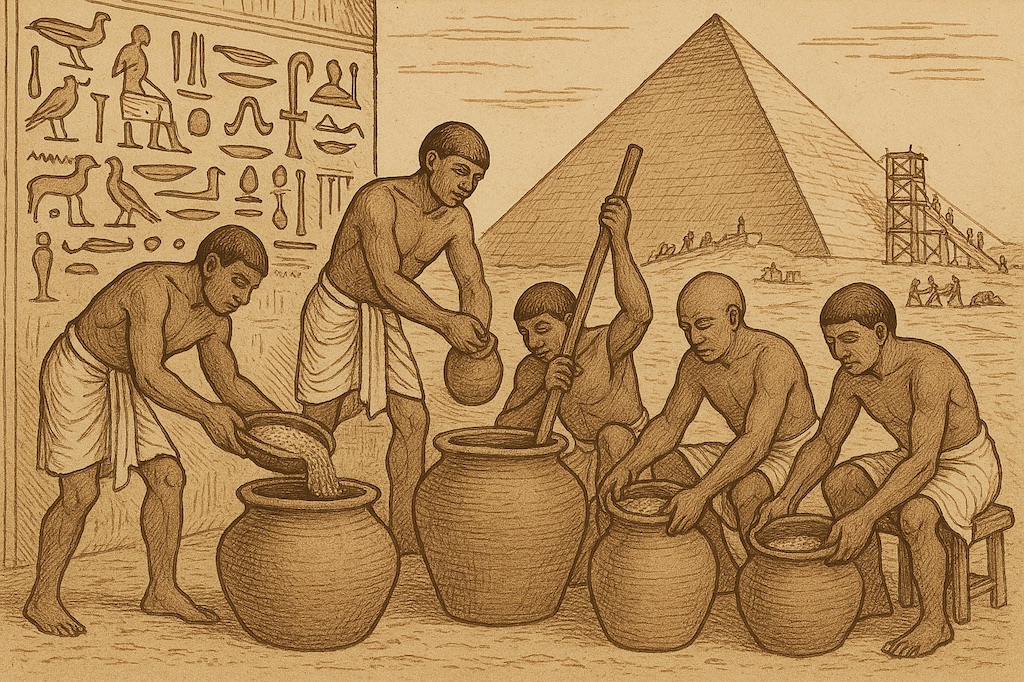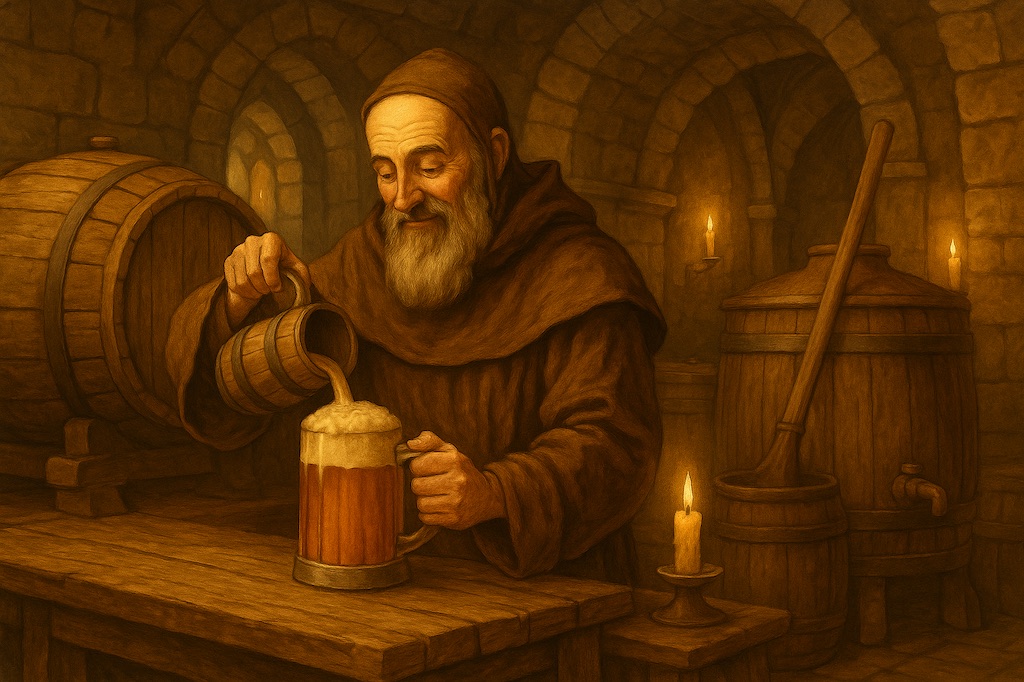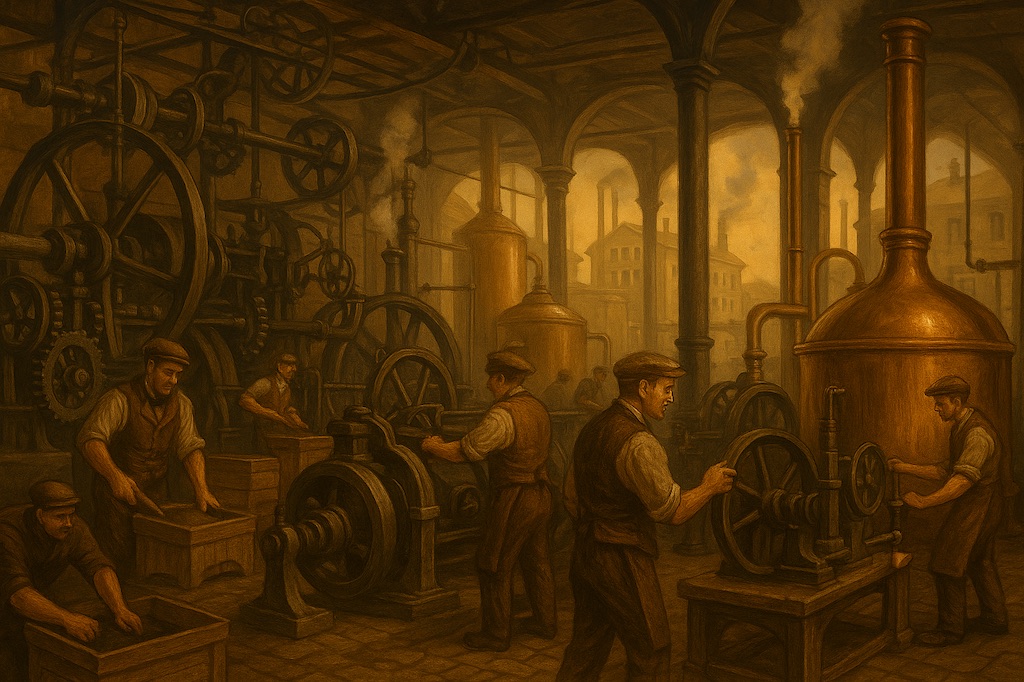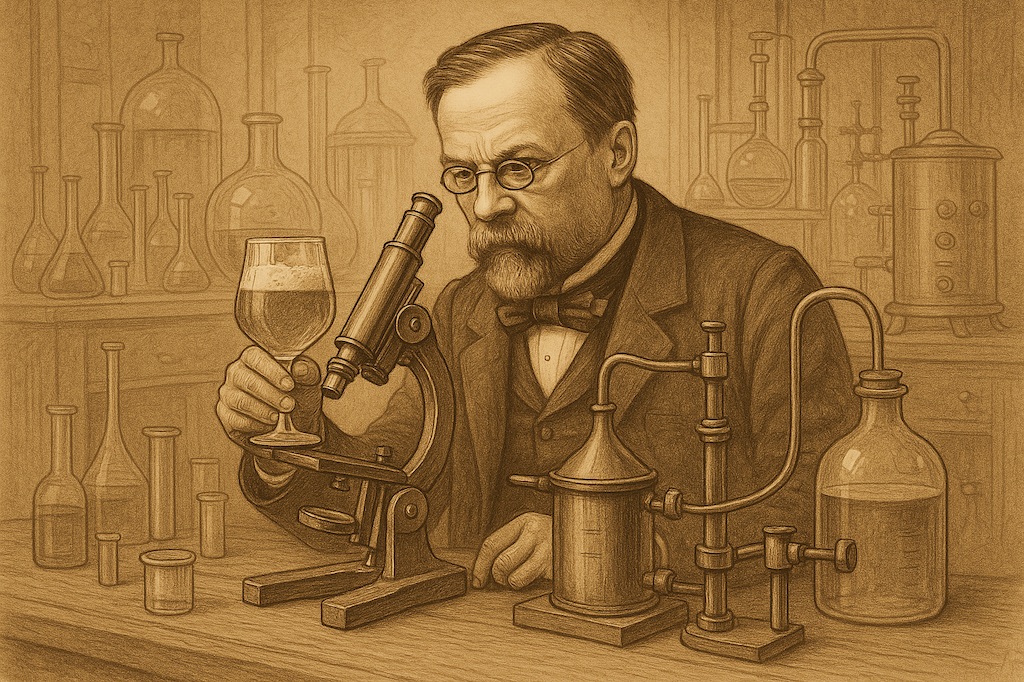Beer: the golden elixir that has lubricated the wheels of civilisation, fuelled revolutions (both industrial and social), and provided solace after a long day since, well, the beginning of days. The history of beer is not merely a tale of fermentation and froth; it’s a sweeping epic that mirrors the rise and fall of empires, the ingenuity of monks, and the relentless curiosity of modern brewers. Whether you’re a casual sipper or a certified cicerone, tracing the journey of beer from its murky, ancient origins to the kaleidoscopic world of craft brewing and non-alcoholic innovation today is to follow the very thread of human progress.
The dawn of brewing: ancient origins
Origins of brewing: accidental genius or divine inspiration?
The origins of brewing are shrouded in the mists of prehistory, likely predating even the written word. The prevailing theory? Beer was born from a happy accident: a forgotten bowl of grain porridge, left to the mercies of wild yeast, transformed into something intoxicating and, crucially, safe to drink. As soon as humans domesticated cereal grains, they unwittingly opened the door to spontaneous fermentation. Archaeological evidence suggests that as early as 7000 BCE, Chinese villagers were brewing rudimentary fermented beverages, while chemical traces of barley beer have been found in Iranian pottery dating back over 5,000 years.
Beer in Mesopotamia: Sumerian ingenuity
The first true beer culture blossomed in ancient Mesopotamia, where the Sumerians not only brewed beer but enshrined it in myth and daily ritual. The “Hymn to Ninkasi,” a poetic ode to the goddess of brewing, doubles as the world’s oldest surviving beer recipe—a testament to beer’s sacred status. In Sumer, beer was more than a drink; it was currency, sustenance, and a social glue. Brewed primarily by women, often priestesses, Sumerian beer was a thick, porridge-like concoction sipped through straws to avoid the floating solids.
Beer in Ancient Egypt: nectar of the Nile
Move over, wine—beer was the true staple of ancient Egypt. Known as “Hqt” (heqet), beer was consumed by everyone from pharaohs to pyramid builders, who received it as part of their daily wages. Egyptian beer was nutritious, sweet, and sometimes as intoxicating as wine, depending on the occasion. The brewing process involved fermenting crumbled bread with water, often flavoured with dates, and was typically the domain of women. Beer was so central to Egyptian society that it featured in religious offerings, medical prescriptions, and even legends—Osiris himself was said to have taught humanity the art of brewing.

Other ancient brewing cultures
While Mesopotamia and Egypt get top billing, early brewing traditions also emerged in China, the Indus Valley, and beyond—each culture adding its own twist to the basic formula of grain, water, and time.
The classical and medieval eras: from household ale to monastic mastery
Beer in Greece and Rome: the underdog
In the classical world, beer played second fiddle to wine. The Greeks and Romans considered beer a rustic, foreign beverage—fit for barbarians and the lower classes. Yet, even in these wine-drenched societies, beer persisted, especially in the northern provinces where grapes were scarce.
Medieval brewing techniques: ale, gruit, and the art of preservation
With the fall of Rome, beer surged back into prominence across Europe. In early medieval times, brewing was largely a household affair, managed by women—“alewives”—who produced unhopped ale for family and neighbours. The flavour and preservation of these ancient brews relied on “gruit,” a heady mix of herbs and spices, long before hops became the standard. Gruit imparted complex, earthy flavours and acted as a natural preservative, making medieval ale a far cry from today’s crisp lagers.
Monastic brewing: the birthplace of quality control
Enter the monks: the true pioneers of medieval brewing. Monasteries became hubs of brewing innovation, elevating beer from a rustic staple to a refined, reliable product. Monks meticulously recorded recipes, experimented with ingredients, and—crucially—began adding hops to their brews. Hops not only improved flavour but extended shelf life, allowing beer to travel further and last longer. Monastic brewing also set the stage for the first quality controls, with guilds and regulations emerging to standardise production and protect consumers.

The Renaissance and early modern period: purity, progress, and the rise of styles
The Reinheitsgebot: purity law beer
In 1516, Bavaria introduced the Reinheitsgebot, or German purity law, decreeing that beer could only be made from water, barley, and hops (yeast would be added to the list once its role was understood). This law, aimed at ensuring quality and preventing price inflation for bread grains, had a profound impact on beer’s evolution, shaping German brewing traditions for centuries and influencing global standards.
Commercial brewing and regional styles
As Europe entered the Renaissance, brewing shifted from home and monastery to the burgeoning world of commercial breweries. Towns established their own breweries, and regional styles began to flourish—pale ales in England, wheat beers in Bavaria, and stouts in Ireland, to name a few. Innovations in equipment and technique, such as improved kilning and fermentation vessels, allowed for greater consistency and experimentation.
The industrial revolution and beyond: beer goes big

Scientific breakthroughs: Louis Pasteur and the microbial revolution
The industrial revolution transformed beer from a local craft to a global commodity. Steam engines powered massive breweries, bottling lines sped up production, and railways expanded distribution. But perhaps the most significant leap came from the laboratory: Louis Pasteur’s work on fermentation and pasteurisation demystified the brewing process, allowing brewers to control yeast, prevent spoilage, and produce beer on an unprecedented scale. Pasteur’s discoveries also paved the way for the development of pure yeast strains, ensuring consistency and safety in every pint.
The rise of lager
While ales had dominated for millennia, the 19th century saw the meteoric rise of lager—thanks to bottom-fermenting yeast and the advent of refrigeration. Lager’s crisp, clean profile and longer shelf life made it the beer of choice for an increasingly urban, industrialised world. By the late 1800s, lager breweries dotted Europe and America, laying the foundation for the global beer giants of today.

The 20th century: turbulence, consolidation, and the craft beer revolution
Prohibition and war: brewing in adversity
The 20th century was a rollercoaster for beer. Prohibition in the United States forced breweries underground or out of business, while two world wars disrupted supply chains and ingredients worldwide. In the aftermath, the industry saw massive consolidation, with a handful of multinational corporations dominating the market and churning out light, mass-produced lagers.
The craft beer movement: a flavourful rebellion
But beer, ever the survivor, staged a comeback. The late 20th century witnessed the birth of the craft beer movement—a grassroots rebellion against bland, industrial brews. Inspired by traditional styles and fuelled by a thirst for flavour, small independent breweries began popping up across the US, UK, and eventually the world. These pioneers experimented with hops, malts, yeasts, and even wild fermentation, resurrecting forgotten styles and inventing new ones. The craft beer movement didn’t just diversify the market; it redefined what beer could be, transforming it into a canvas for creativity and local identity.
The modern era: diversity, innovation, and the future of beer
The global beer scene: a world of styles
Today, beer is as diverse as humanity itself. From the farmhouse saisons of Belgium to the hop-bombs of California, the evolution of beer styles reflects a global tapestry of tastes, traditions, and innovations. The craft beer movement has gone global, with microbreweries and brewpubs flourishing in every corner of the world. Even traditional brewing nations, like Italy and Poland, are experiencing their own craft revolutions, blending local ingredients with international trends.
Craft beer market growth and trends
The global craft beer market continues to surge, valued at $142.6 billion in 2024 and projected to reach $329.7 billion by 2033, growing at a CAGR of 8.74%. Europe leads the charge, holding over 38% of the market, but North America, Asia-Pacific, and South America are all seeing robust growth. Key drivers include rising consumer demand for unique flavours, the popularity of beer tourism, and a growing preference for locally brewed, artisanal beverages—especially among millennials and Gen Z. Innovative marketing, digital engagement, and direct-to-consumer sales are also expanding the reach of small brewers.
AI-assisted brewing and digital innovation
Artificial intelligence is revolutionising brewing in 2025. Breweries are leveraging AI for everything from recipe development—where algorithms suggest novel ingredient combinations—to real-time fermentation monitoring and predictive maintenance, ensuring consistency and reducing waste. AI-driven demand forecasting helps breweries optimise production and inventory, while digital-first experiences—like virtual tastings, AR labels, and personalised beer recommendations—are captivating tech-savvy consumers. Some breweries, such as the UK’s IntelligentX and St Austell Brewery, are already releasing AI-developed beers, cutting new product development times and tailoring recipes to evolving consumer tastes.
Experimental and functional beers
Innovation isn’t limited to technology. Brewers are experimenting with hyper-local ingredients, indigenous botanicals, and even upcycled foods like surplus bread, reflecting both a commitment to sustainability and a desire to create distinctive regional flavours. Probiotic beers, which promote gut health, and beers with functional benefits—such as added vitamins or adaptogens—are gaining traction among health-conscious consumers.
The rise of non-alcoholic beer and health trends
The non-alcoholic beer market is exploding, projected to reach $34.97 billion by 2032 and growing at a robust CAGR of 7.3% from 2025 to 2032. In 2025, non-alcoholic beer is set to surpass ale as the second-largest beer segment by volume globally, thanks to a 9% worldwide volume increase in 2024 alone. Millennials and Gen Z are leading this shift, embracing “sober curious” and “damp lifestyle” trends that prioritise moderation without sacrificing social rituals or flavour. Modern non-alcoholic beers now rival their alcoholic counterparts in complexity, with breweries investing in advanced techniques like vacuum distillation and arrested fermentation to enhance taste and authenticity. The category is diversifying rapidly, with NA stouts, sours, IPAs, and even craft-inspired lagers gaining popularity.
Sustainability in brewing
Sustainability is a defining force in 2025, with breweries adopting eco-friendly practices at every stage of production. Water stewardship is paramount; many are recycling wastewater, using dry-lubrication on bottling lines, and investing in on-site treatment facilities. Energy efficiency is another focus, with breweries installing solar panels, wind turbines, and switching to renewable energy sources. Local and organic sourcing is on the rise, supporting regional economies and reducing carbon footprints. Breweries like Allagash in the US have set benchmarks, using half the industry’s average water per gallon of beer and diverting nearly all waste from landfills, while also investing in their communities and employees. Circular economy models are emerging, turning spent grains into granola bars, animal feed, or even new brewing substrates.
The history of beer and its impact on civilisation
It’s easy to overlook the profound impact beer has had on human history. Beer helped drive the Neolithic Revolution, encouraging the cultivation of grains and the formation of settled communities. It served as currency, sustenance, and social glue in ancient societies. Monastic brewing preserved knowledge through the Dark Ages, while industrial brewing fuelled urbanisation and economic growth. Today, beer continues to bring people together, spark innovation, and reflect the ever-changing tastes of civilisation.
Looking ahead: the future of beer
The future of beer is one of diversity, innovation, and responsibility. Expect to see:
- AI-driven, hyper-personalised brewing: Imagine taprooms offering custom brews tailored to your palate, designed by algorithms and brewed on demand.
- Probiotic and functional beers: Blurring the line between beverage and wellness product, these beers will cater to health-focused consumers.
- Explosive growth of non-alcoholic and low-ABV beers: The NA category is expected to reach $35.35 billion by 2029, growing at a CAGR of over 10%.
- Sustainability as standard: From carbon-neutral breweries to regenerative agriculture, environmental stewardship will be non-negotiable.
- Continued globalisation and local innovation: The rise of craft and NA beers in Asia-Pacific, South America, and Africa will further diversify the global beer landscape.
Conclusion: beer’s enduring journey
From the accidental fermentation of ancient porridge to the kaleidoscopic world of craft IPAs, AI-brewed lagers, and alcohol-free sours, the history of beer is a testament to human creativity, resilience, and community. Beer has quenched thirsts, inspired poets, and even shaped the course of civilisation. As we raise our glasses to the past, we also toast to the future—a future where beer, in all its forms, continues to evolve, surprise, and unite us. Cheers to the next chapter in the world’s oldest love affair.
What’s your favourite chapter in the history of beer? Have you tasted a brew that feels like drinking history itself? Share your thoughts below—after all, every great beer deserves a great conversation.

